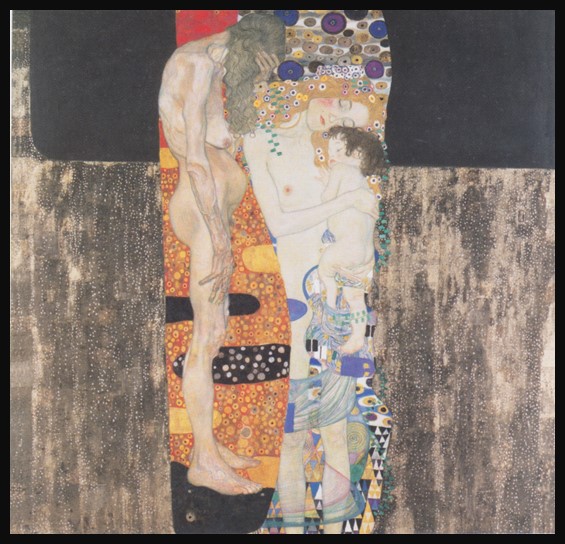
The Three Ages of the Woman, 1905, Oil on Canvas, 180 × 180 cm, Galleria Nazionale d’Arte Moderna e Contemporanea, Rome Italy https://upload.wikimedia.org/wikipedia/commons/c/c8/Klimt_-_Die_drei_Lebensalter_der_Frau.jpeg
Presenting the painting The Three Ages of the Woman by Gustav Klimt is my humble contribution to Mother’s Day!
Gustav Klimt (1862–1918), an Austrian symbolist painter, was a pivotal figure in the Viennese Secession movement and a prominent member of the Art Nouveau movement. Renowned for his ornate and sensual style, Klimt’s work often explored themes of love, sexuality, and the human condition, characterized by elaborate compositions, intricate patterns, and rich symbolism. He is best known for his iconic paintings such as “The Kiss” and “The Portrait of Adele Bloch-Bauer I.” Klimt’s artistic vision transcended conventional norms, influencing generations of artists and leaving an indelible mark on the history of art.
Gustav Klimt’s artistic style is characterized by its ornate and sensual qualities, marked by intricate patterns, rich symbolism, and a vivid colour palette. Influenced by the Art Nouveau movement and the Viennese Secession, Klimt’s works often feature decorative elements inspired by Byzantine art, Egyptian motifs, and Japanese woodblock prints. His compositions are meticulously crafted, with every detail contributing to the overall aesthetic harmony of the piece. Klimt’s exploration of themes such as love, sexuality, and the human psyche is evident in his paintings, which often depict intimate moments and the complexities of human relationships.
One of Klimt’s distinctive traits is his use of gold leaf, which he employed to stunning effect in many of his works, symbolizing spiritual and material wealth, as well as the transcendence of earthly concerns. This shimmering gold backdrop serves to elevate his subjects, lending them an otherworldly quality and reinforcing the ethereal nature of his art. Additionally, Klimt’s portrayal of the female form is notable for its sensuality and eroticism, as he often depicted women with flowing hair draped in luxurious fabrics, evoking a sense of both beauty and mystery. Overall, Klimt’s artistic characteristics reflect a profound exploration of the human experience, expressed through a visually captivating and emotionally resonant aesthetic.
Gustav Klimt’s painting The Three Ages of Woman, completed in 1905, encapsulates the artist’s exploration of life, death, and the passage of time. The painting shows a little girl in the protective arms of her mother, while beside them an old woman stands with a bowed head. The infant represents the beginning of life and the promise of new beginnings, the mature woman, lost in contemplation, symbolizes the complexities and responsibilities of adulthood, and lastly, the elderly woman, signifies the culmination of life’s journey. Depicting a woman in three distinct stages of life—youth, maturity, and old age—the painting symbolizes the cyclical nature of existence and the inevitability of mortality. Through his masterful use of colour, pattern, and symbolism, Klimt imbues the painting with a sense of timeless beauty and existential depth, inviting viewers to reflect on the fleeting nature of human existence and the enduring cycle of life and death.
Completed in 1905, Gustav Klimt’s The Three Ages of Woman swiftly gathered attention, being presented at the 2nd Exhibition of the Deutscher Kunstlerbund in Berlin the same year. Its acclaim only burgeoned when showcased at the Venice Biennale in 1910, captivating audiences with its profound symbolism and exquisite execution. Its journey continued as the painting was selected for display at the International Exhibition in Rome in 1911, where Klimt’s artistic prowess earned him the gold medal in the Austrian pavilion. Housed in the newly established National Gallery of Modern Art in Rome, The Three Ages of Woman remains a testament to Klimt’s refined elegance and enduring fame, securing its place as one of the great allegorical paintings of art history.
For a PowerPoint, titled 12 Painting by Gustav Klint, please… Check HERE!
Bibliography: https://artsandculture.google.com/story/gustav-klimt-the-three-ages/8QVBXs2pR3BlKg